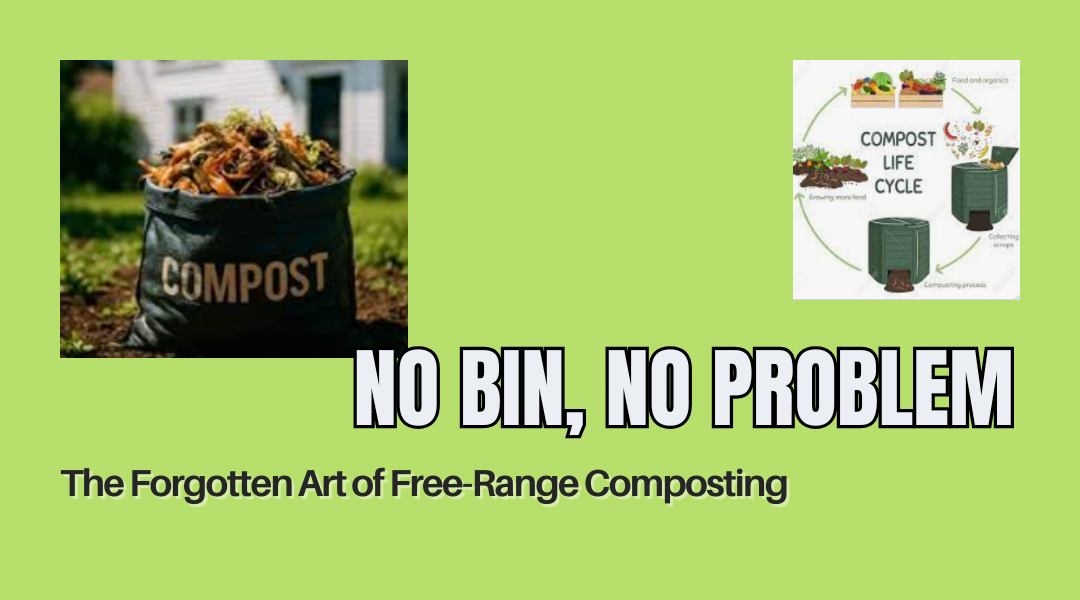Let’s bust a myth: you don’t need a fancy tumbler or a $200 compost bin to turn kitchen scraps into black gold. In fact, some of the richest compost happens when we step back and let nature do its thing—no containers, no turning, no fuss.
Ditch the Bin: Two Ways to Compost Au Naturel
- The Lazy Gardener’s Heap – Just pile up leaves, grass clippings, and veggie scraps in a corner of your yard. Let time and microbes do the work.
- Trench Composting (AKA: Bury-and-Forget) – Dig a hole, dump your scraps, and let the earthworms throw a underground decomposition party.
Why go bin-free?
- Zero cost – No bins to buy, no tools needed.
- Stealth mode – Great for urban gardeners with nosy HOAs or tiny yards.
- Direct soil feeding – Nutrients seep right where plants need them.
The Underground Buffet: Trench Composting Demystified
Picture this: instead of dragging a sloshing compost bucket across your yard, you’re burying apple cores and coffee grounds right where your tomatoes will grow next season. That’s trench composting in a nutshell.
Pro tips for success:
- Location matters – Bury scraps 12+ inches deep near (but not under) future plants to avoid root rot.
- Layer like lasagna – Alternate food scraps with browns (leaves, shredded mail) to prevent sludge.
- Speed it up – A sprinkle of blood meal or used coffee grounds turbocharges decomposition.
Urban gardener hack: No yard? Use a post-hole digger to create mini compost pockets between patio planters.
The “Windrow” Method: For Serious Scrap Generators
If you’ve got acres or a serious veggie habit, try windrows—long, narrow piles that look like lazy snakes of leaves and grass clippings. Farmers have used this for centuries because:
- It scales endlessly – Got 50 bags of autumn leaves? No problem.
- Self-aerating – The pile’s shape lets air circulate naturally.
- Wildlife buffet – Birds and beneficial insects love foraging in these piles.
Warning: This isn’t for neatniks. Your pile will look like a raccoon’s frat house by week three.
What NOT to Bury (Unless You Want Trouble)
- Dairy/meat – Creates odor bombs that attract every dog in the neighborhood.
- Citrus peels – Too acidic for worms; they’ll bail on your decomposition party.
- Weeds with seeds – You’re just planting next year’s headache.
Genius trick: Mark burial spots with colorful golf tees. When they start leaning (as decomposition settles the soil), you’ll know the compost is ready.
Why Your Soil Loves This More Than Bagged Fertilizer
Unlike store-bought compost that sits on the surface, trench composting:
- Builds worm highways – Earthworms tunnel through buried scraps, aerating soil.
- Prevents nutrient runoff – Rain can’t wash away what’s already underground.
- Creates secret pantries – Plant roots grow toward these nutrient caches like kids to a cookie jar.
Fun experiment: Bury a pumpkin whole come November. Dig it up in spring—you’ll find a collapsed shell full of vermicompost gold.
The No-Sweat Harvest
Here’s the beauty part: there isn’t one. Unlike bin composting where you’re constantly turning and sifting, underground composting works while you sleep. Just plant near (not on top of) last season’s burial sites and watch your plants thrive.
For impatient gardeners: Stick to fast-rotting scraps (coffee filters, wilted lettuce) in spring trenches. Save slower items (corn cobs, nut shells) for autumn burials.
Final Thought: Composting Like Your Great-Grandparents Did
Before Instagram-worthy compost stations existed, people just fed the earth directly. Whether you’re guerrilla composting in a rental’s backyard or prepping a future orchard site, sometimes the old ways are best.
